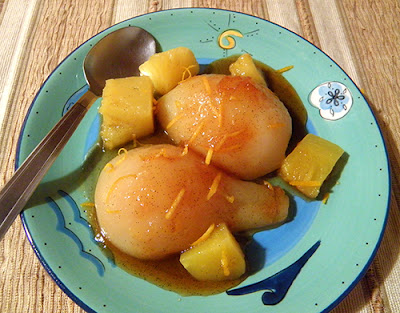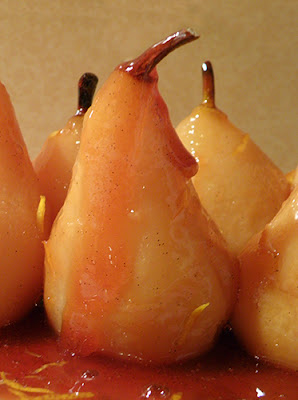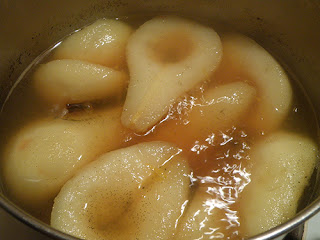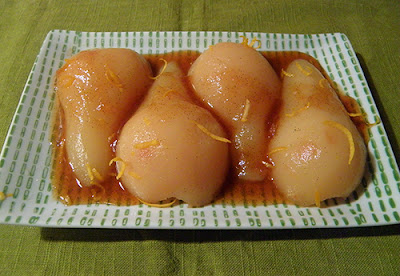 |
| Bosc (lower) and D'Anjou Poached Pears with Pineapple |
Recipe by Robin
I don’t know about you, but every winter I start
dreaming about the tropics. Imagining abandoning my shoes, socks, jeans, and
jacket (but not my hat) to walk carefree on some secluded beach. Donning
flip-flops—known as slippers in my favorite locales—and heading over to the
local farmers’ market to check out what produce can be grown in red dirt with
plenty of rain and sun. Flirting with strange fruits and their vendors,
chatting with local craftspeople, and selecting the most luscious from a huge
number of pineapples by their scent. Alas, a trip to Kauai isn’t in the budget
at the moment, but a can of organic pineapple chunks can add a sun-kissed touch
to winter pears here on the mainland, especially when combined with a sweet
California wine.
 |
| Recipe Adapted for Whole Pears |
Firm winter pears are best for poaching. Don’t use overripe
fruit. Boscs are classics for poaching, because they hold their shape, which is tall, curvy, and elegant. I’ve also had success with D’Angou. These are
softer and require less cooking time, but have fewer stone cells, so are
smoother in texture. Their shorter, chubbier shape looks fine when cut in half.
 |
| The Poaching Process |
serves 6
5 - 6 firm pears
1 tbsp. lemon juice
water
1½ cups moscato or other sweet fruity wine
1 cup water
14 oz. can of
organic pineapple chunks
6 tbsp. dark brown sugar
1 - 2 tbsp. Meyer lemon juice
1 vanilla bean
½ tsp. Meyer lemon zest
Extra Meyer lemon zest: optional garnish
Fill a large bowl with water and add 1 tbsp. lemon juice to
acidulate it. This will prevent the pears from turning too brown.
Peel pears, cut in half from top to bottom, and remove
cores. Immediately slip each pear half into the acidulated water.
Split vanilla beans lengthwise and cut in half crosswise.
Open up each piece of bean to expose the insides (they may close up again, and
that’s okay).
Drain pineapple juice and measure out ½ cup. You might have
to squeeze the fruit a little to get this amount.
Combine wine, 1 cup water, pineapple juice, brown sugar, 1
tbsp. lemon juice, vanilla bean pieces and ½ tsp. lemon zest in saucepan. Add
as many pear halves as can be submerged. Leave any extras in acidulated water.
Bring liquid to a boil over medium high heat. Check to see
if more pear halves can be added. Often you can add 1 – 2 halves. Lower heat to
medium and cover to simmer.
Keep pears at a medium simmer. Cook until soft, but don’t
overcook so they’re mushy. If a sharp knife can pierce them without resistance,
they’re done. This will take about 20 minutes, and vary depending upon pear size,
type, age, etc.
Add pineapple chunks and cool the pears, pineapple, and
liquid.
If you choose to serve them as is with their liquid: remove the vanilla beans and store in the
refrigerator. Serve when completely chilled, garnished with lemon zest.
If you choose to serve them with sauce:
Remove pears
and pineapple from liquid with slotted spoon. Chill pears and pineapple in
refrigerator.
Scrape the insides off each vanilla bean and add the vanilla
granules to the liquid, discarding the hulls.
Cook liquid over medium high heat, stirring frequently, until liquid is just visibly thickened. This will take about 30 minutes and result in about 3/4 cup of sauce. Chill sauce in refrigerator (it will thicken more as it cools.)
Serve pears and pineapple drizzled with sauce and garnished with lemon zest.
 |
| Recipe with Pineapple Juice and Bosc Pears, no Pineapple |

No comments:
Post a Comment